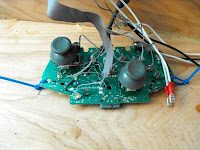I, like many others, pay a lot for home phone service, which is becoming increasingly obsolete with the ubiquity of cellular phones. In an effort to cut out this mostly needless expense, I decided to try and combine two free services, Google Voice and Gizmo5, to make and receive free calls with actual landlines and cell phones via my existing internet connection.
The concept works like this: when you sign up for a Gizmo5 account, they assign to you a free
SIP number, which you can basically think of as an IP-based phone number. This is already pretty cool, but the catch is that only other IP-based phones can call this number, and that's where Google Voice comes in. Through this free service, Google will connect any number--physical or SIP--with any other number--again, physical or SIP. Once the initial connection is made (the hard part for Gizmo), Google steps out and you're left with a working SIP-to-landline call without a phone line and without paying a dime.
To get this sweet deal going, you have to have an account with both services, which could be the biggest stumbling block: Google Voice is currently in an invite-only, privite beta stage and Gizmo5 has stopped accepting new registrations after it was recently acquired by Google (existing accounts still work, though).
If you've managed to snag some accounts, though, and they are all set up (you've chosen a local phone number for Google Voice, Gizmo has assigned a SIP number, etc.) you're ready to get started.
First, open your Gizmo5 account in your favorite web browser and find your SIP number (it will have an area code of 747):

Next, open your Google Voice account and click on 'Settings.' Under the 'Phones' tab, click 'add another phone' to forward your calls to:

Name it something recognizable (I called it 'Gizmo'), type in your Gizmo SIP number into the second blank, and then select 'Gizmo' from the pull-down menu:

Next, we'll want to install the Gizmo5 client on our computer (you can also use the
gizmocall web-based interface, but it is made in flash and feels a little kludgy). Go to
Gizmo's download page and download the client program for your operating system. If you're using Linux (like me), you'll notice that this is a bit of a problem, as the links are all missing. Luckily, you can still download the deb installer file for Debian-based distros, such as Ubuntu, from a
direct link.
UPDATE: the Linux download page is back!
Once the client is installed and running, you can enter your Gizmo account information and login. You can also choose to configure the client to manage your IM accounts, but I chose not to.
From now on, calls made to your Google Voice number--which is accessible to normal phones, either landline or cellular--will cause your Gizmo5 client to 'ring.' That means we can now receive calls from normal phones on our computer! We can also
make calls to normal phones, but the trick is to use Google Voice instead of Gizmo's built-in (for-pay) calling feature:

When you click 'connect,' Google will call your Gizmo client (you answer it when it rings) and then call the number you have entered, merge the two calls, and then step out, just like your own personal secretary:
 Conclusions
ConclusionsThis method is not a perfect replacement for a home telephone. It only works when you have internet access (the silver lining of which is that you can use it at Starbucks, your hotel room, etc.; anywhere with a broadband connection). More importantly, it doesn't provide emergency 911 access, so if your house catches on fire, you'll just have to watch it burn because the fire department won't be able to look up your information via your phone number.
Furthermore, this method may not work forever. Google has just purchased Gizmo, so things are sort of up in the air until they figure out what they want to do about the way the services interact. Hopefully, if anything changes, it will be for our--the users'--benefit.
There has also been speculation that Google is planning to fully integrate these services together and then make them run on a wifi-enabled mobile device (Android-based, of course). This will essentially create a mobile phone that only works within wifi, but that can make and receive calls to/from any other phone
without the need for a carrier (no carrier means no contract, no fees, etc.). That is, a fully ad-supported phone powered entirely by Google services and software.
Google, if you're reading this with your all-seeing robot eyes, please make it happen as soon as possible.












































